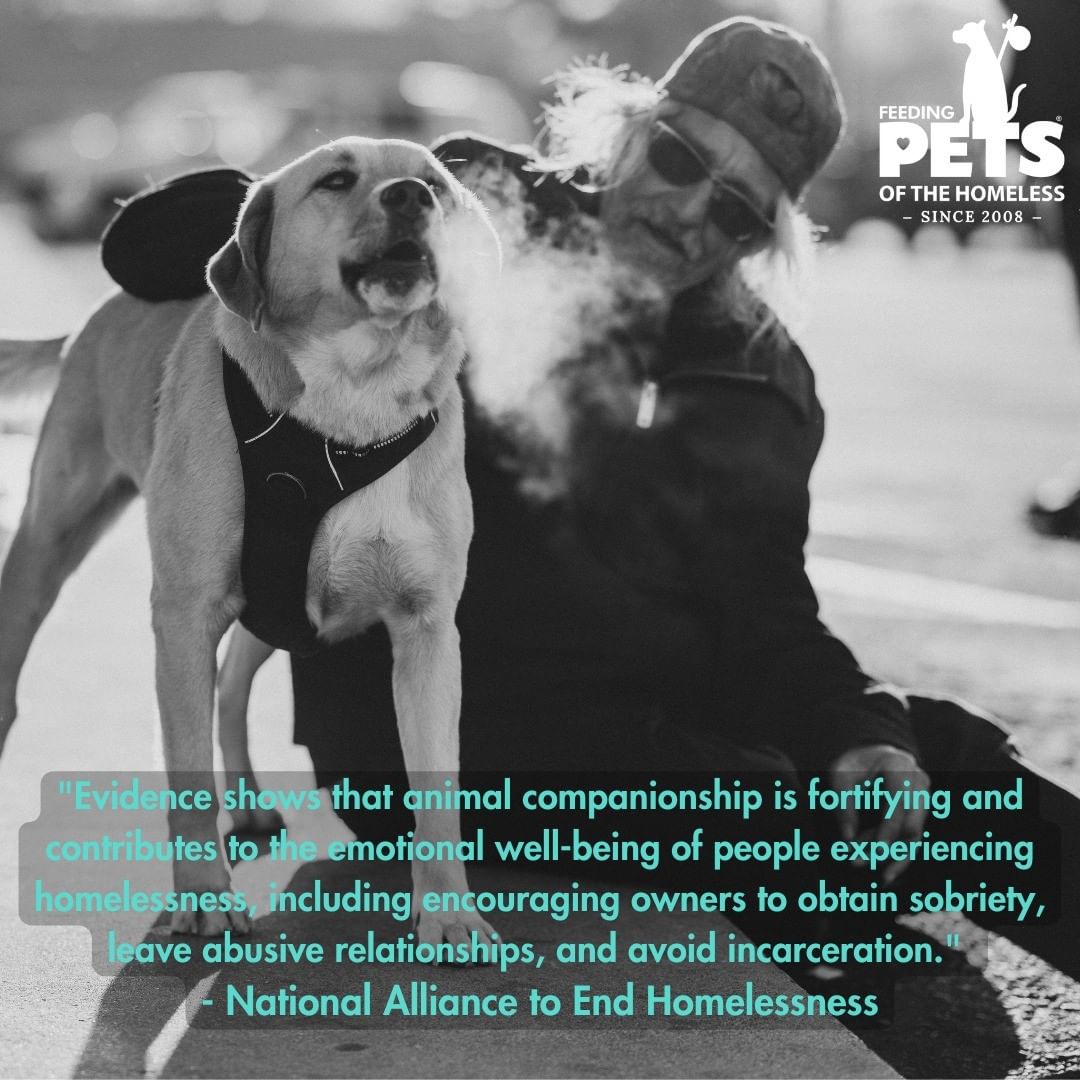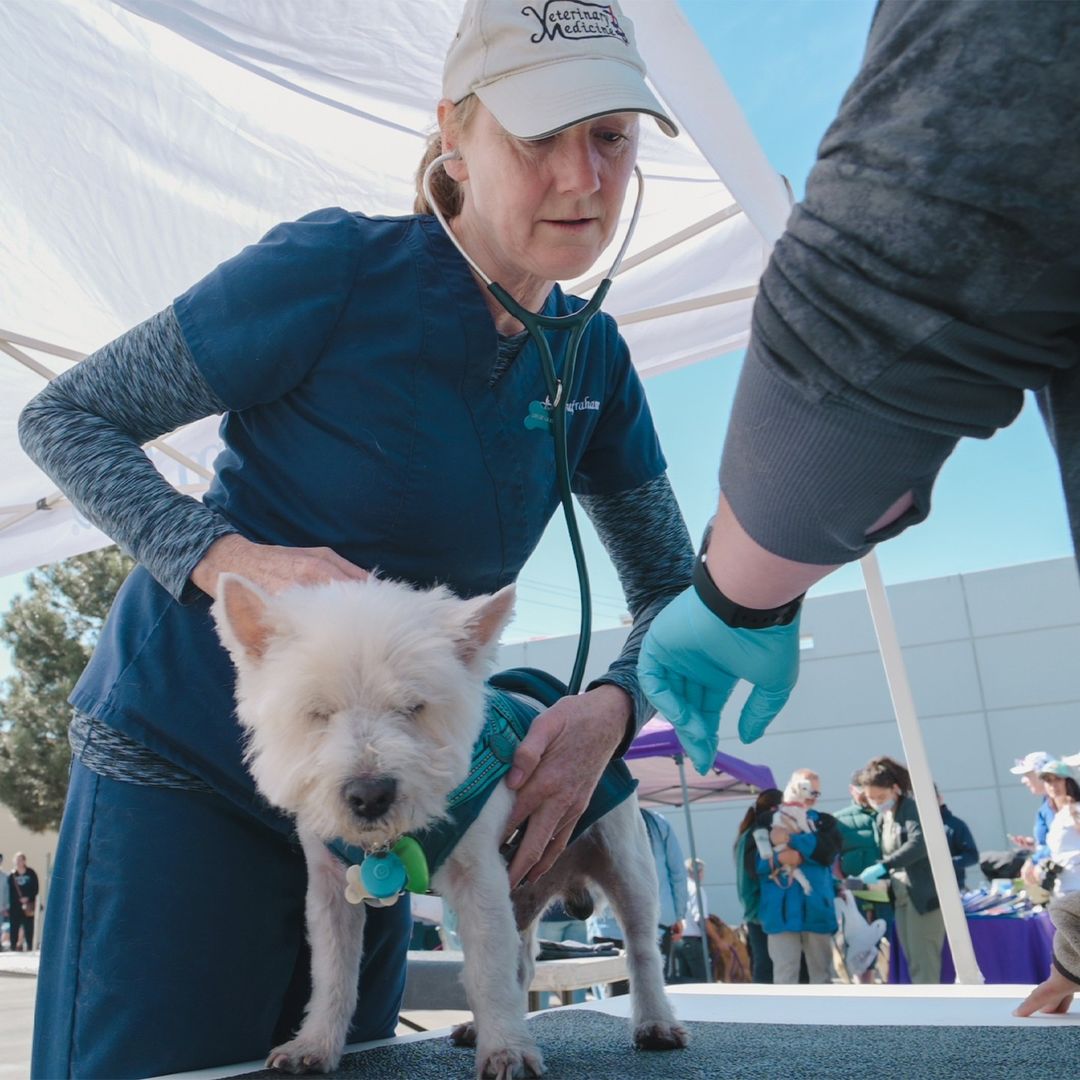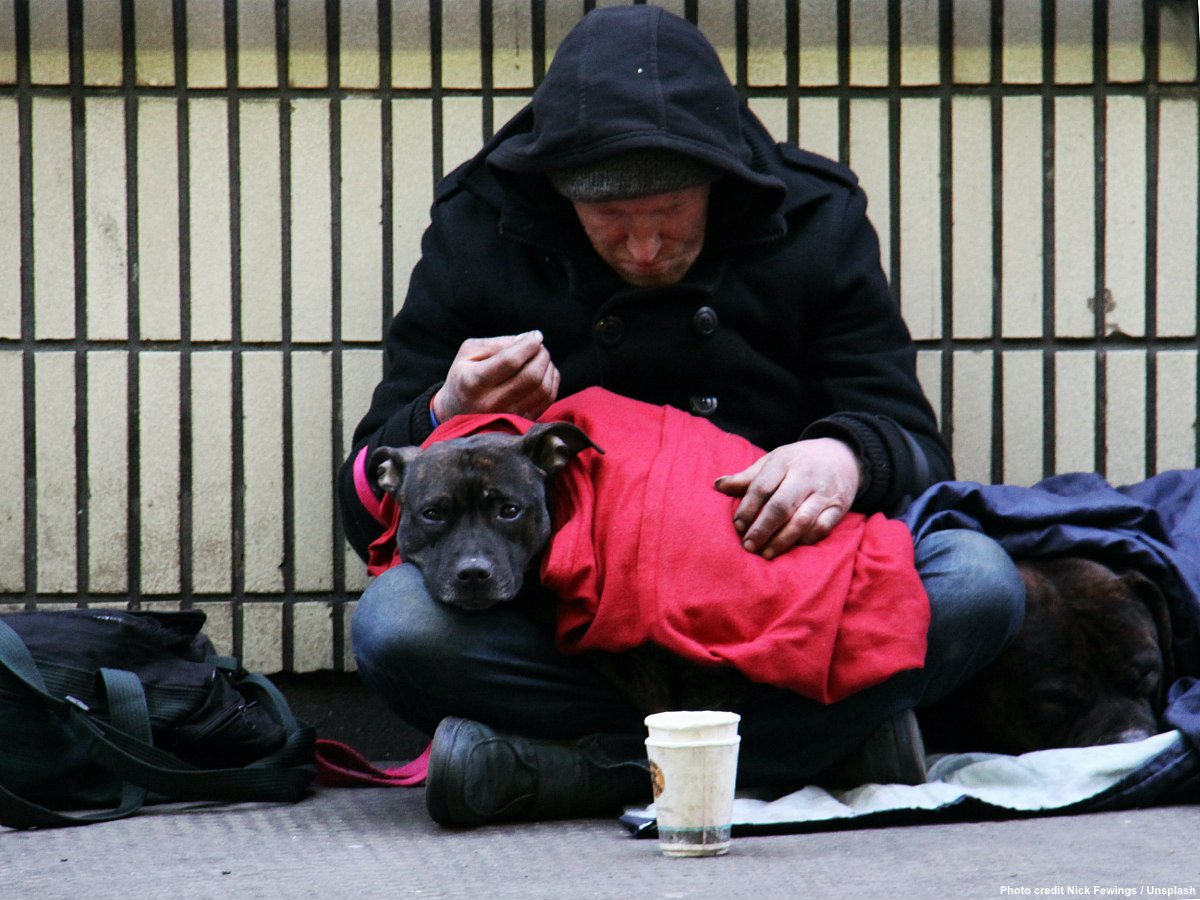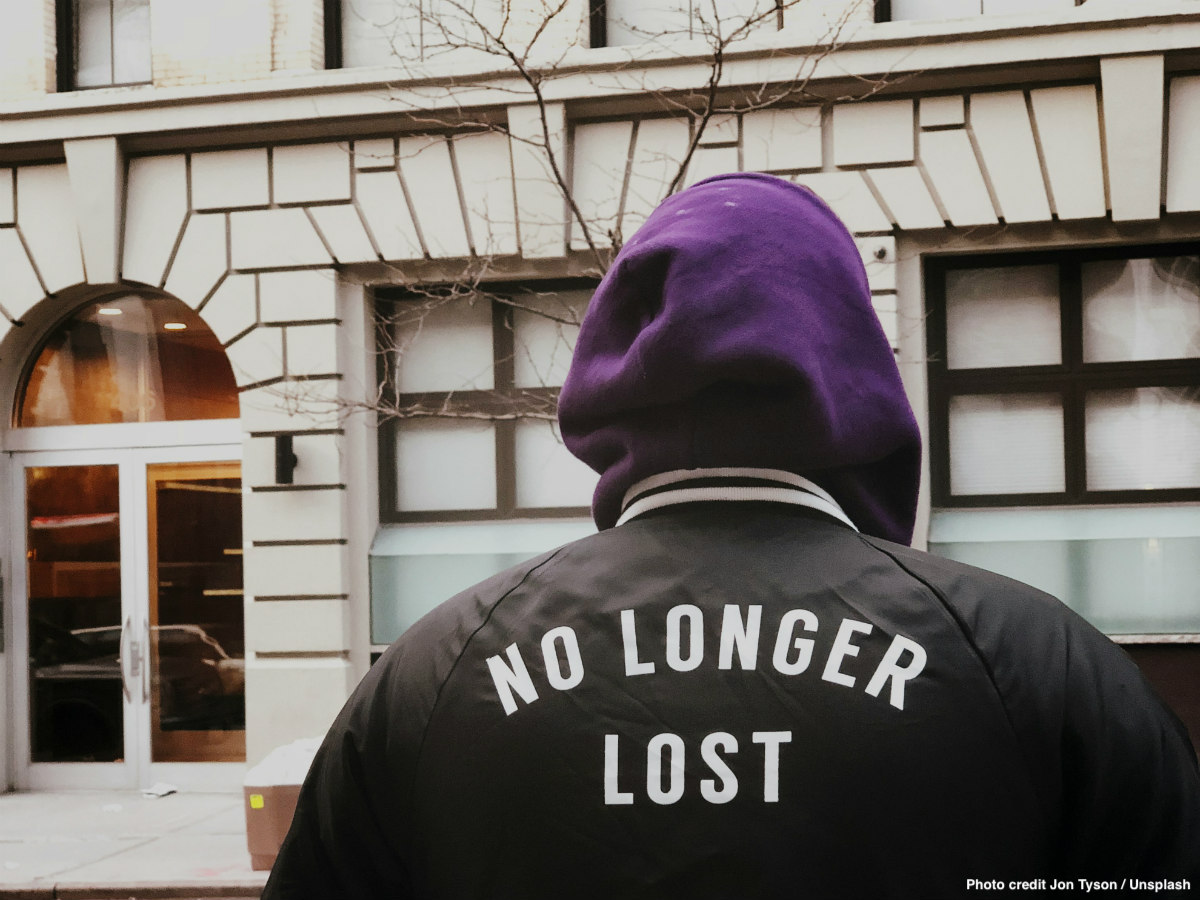I still can’t get them out of my mind’s eye, months later. I see them wherever lack resides and need arises, which feels to be the case in every city throughout our nation as of late. The gilded City of Boulder, Colorado, has become the situs of ubiquitous tent cities, as has the City of Denver down the Turnpike. People in their cars pass middle-aged men setting up tents in local city parks, while others stand on street corners and highway exit ramps holding signs:
“A little bit of kindness helps.”
It was in the reality of our changing society this past August, when I was leaving my afternoon shift at the Humane Society of Boulder Valley. I turned the corner at Arapahoe and 55th Streets in Boulder, and saw the family:
A multi-colored, older Pittie mix was walking cautiously and slowly in front of a shopping cart. Behind him, an older man pushed an overflowing shopping cart in one hand with the arm of his partner’s wheelchair in another. Together, the sixty-something couple quietly and steadily rolled along the sidewalk. All the signs of long-term homelessness and the organic debris intrinsic to a life outdoors were there for all to see.
And mindfully, with all the patience of a Buddhist llama, their dog stayed in line and lockstep, as they rolled and stepped along the sidewalk in unison. I was captivated by their docile unity and enthralled with the loyal Pittie. A Land Rover honking behind broke my reverie.
Traffic was pulsing behind me, signaling the need to move onward, barring my impulse to dole out dog treats or pull over to offer dog kibble or some change to the family. I drove, instead, for my own homeland in the mountains, holding that struggling family in my heart and carrying their collective image forever in my mind.
These scenes are becoming all too common in American cities. Most of us sigh, lift our gaze up to the heavens in gratitude, and utter relief that we are not so vulnerable. And yet, all of us – each and every one – is just as vulnerable as that family and their dog to such downfalls. There are people in our society who understand this aspect of our new reality on an intimate level. I was fortunate to come to know her, months later.
Genevieve Frederick founded the nonprofit Feeding Pets of the Homeless in Carson City, Nevada, after feeling the desperation and suffering on a deeply transformative level on a trip to New York City, a place replete with wealth and corresponding poverty. She saw through the dark density of poverty and people experiencing homelessness into the light of creative alternatives to help them through their constant companion.

While some may feel a person without a home should be barred from possessing a pet, the reality is far different. In a time of shelter overcrowding, surrendering a pet also means putting them at risk of euthanasia, for thousands of homeless animals are losing their lives for lack of space. Such options are unthinkable for anyone living life on the streets, where their dog or cat is their comfort and their protection, their reason for getting up in the morning.
For any one of us living life with an animal, the feeling resonates. Regardless of how any one particular reality manifests into our new circumstances, homelessness and its victims are a phenomenon of our affluent, dynamic, and struggling society. Some may ultimately find permanent housing, while others may simply fall down in despair without the means to get back up. Resilience is not an inexhaustible resource, and over the course of time, diminishes as the prospects fade into the horizon. Some will seek help, limping along for a time. Many will walk the streets of our urban centers pushing shopping carts filled with all they own. Even more will seek refuge with the only living being left who cares for them, and for whom they care for: their dog or cat.
For those needing the statistics: Every year, 4.5 million young people in the United States go through some level of homelessness and between 10% – 25% have a pet, which means that around 450,000 to 1,125,000 pets are on the streets with their homeless guardians. Unhoused young people have reported delaying seeking help or refusing services altogether if it meant they would be separated from their pets.
According to Feeding Pets of the Homeless, 5% of their clients are over 65 years old, 10% are veterans and 61% are women. Many homeless insist that “their animal companion is their best friend and oxygen without whom life wouldn’t be worth living,” says Genevieve Frederick based on testimonials and conversations with the homeless.
In a country experiencing increasing wealth disparity, rampant inflation, decreased personal power among its citizens and perennial political strife, survival for people with pets with lesser means is dependent upon such organizations. Since 2008, Feeding Pets of the Homeless has raised funds from grassroots, corporate and private donors to provide life-sustaining veterinary care and wellness clinics, food and pet supplies to the animals accompanying their people.

People caring for the sole survivor of the vestige of their previously prosperous civilized lives are not only intensely bonded to their animals, but sleep better in their tents alongside their companions at night. If opportunity allows and shelters permit, Feeding Pets of the Homeless provides crates for these pets, so that everyone, including families as the one tooling along Arapahoe Avenue this past August, can sleep together.
Logistically, a person experiencing homelessness speaks with a real person on the telephone. In a moment of compassionate listening, needs are assessed and wants can be addressed. A service request number is provided to the partnering veterinary hospitals or clinics; invoicing and client communication revert to Feeding Pets of the Homeless, which provides what’s being called for in the form of veterinary care, medicine, treatment or surgery.
That person can feel supported, assisted and provided what they need to care for their last remaining companion. And as any dog lover will understand, the needs of our canines can vastly differ. In cases of homeless pets, they present even greater challenges such as the need of antibiotics to clear up an eye infection or any other medicine to care for intestinal distress emanating from a moldy hamburger picked up in an alley, among many others.
Or maybe, they simply need a bag of dog kibble or a can of wet food, to replace the tuna and peanut butter given, because the government welfare program, SNAP, excludes pet food. Whatever the need and regardless of the cost, Feeding Pets of the Homeless provides it through the generous, compassionate, and life saving donations of America’s dog lovers, veterinary professionals, corporations, and others simply wishing to create a better society in which we all may live.
It’s hard to fathom any one particular reason, or understand why the sociopolitical landscape of our nation has fallen apart. Why some have fallen through the cracks of society. Or whether you feel the need to blame people personally for their failings in life or feel that if they just tried hard enough to pull themselves up by their own bootstraps, they’d succeed, the situation all triggers that uncomfortable feeling that none of us ever want to acknowledge: All of us, but for the grace of life and circumstances into which we are born, are vulnerable to the bottom falling out. And when it does, would you not want your best beloved canine friend by your side, and know that there were people there, willing to help him, along the way?
***
How much Feeding Pets of the Homeless helps:
- Number of Pets Helped: 26,000
- Amount of Pet Food Collected: 1,791,391 pounds or 895 tons
- Number of Pet Food Banks Nationwide: 485
- Amount Given in Veterinary Care, Pet Food and Crates: $3,459,400
(Pet Crates are provided to homeless shelters for temporary housing of pets while their person is in the shelter)




